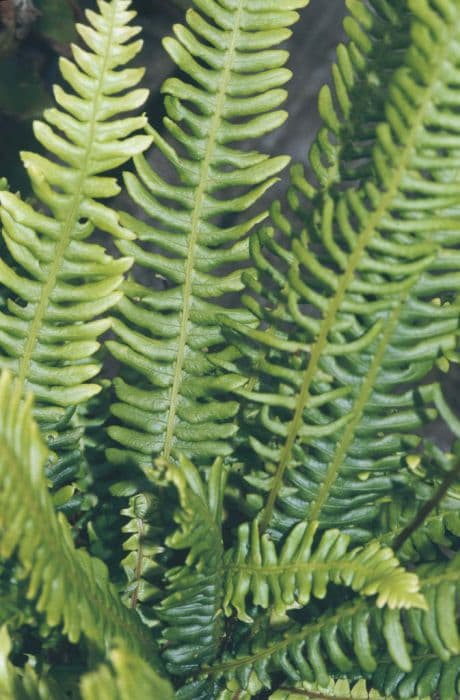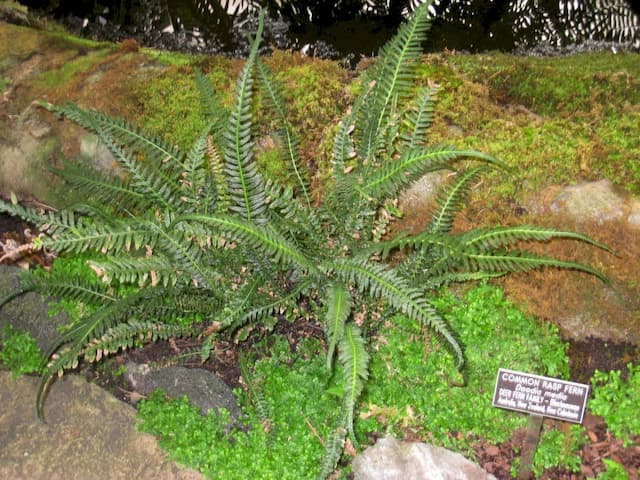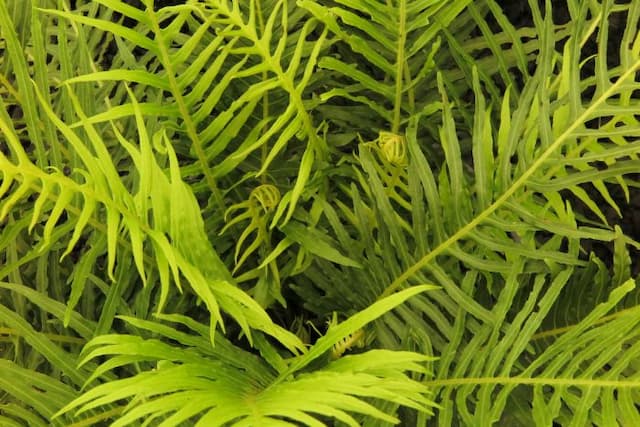Dwarf Brazilian tree fern 'Volcano' Blechnum brasiliense 'Volcano'

ABOUT
'Volcano' is an evergreen fern reaching a height and spread of 1.5m by 1m. The erect to arching fronds are slightly-crinkled; new fronds emerge an intense red colour before maturing to bronze then glossy green. Over time, the erect rhizome will create a thin trunk up to 30cm high
About this plant
 Names
NamesFamily
Blechnaceae
Synonyms
Brazilian Dwarf Tree Fern, Red Dwarf Tree Fern, Volcano Fern
Common names
Blechnum brasiliense 'Volcano'.
 Characteristics
CharacteristicsLife cycle
Perennials
Foliage type
Evergreen
Color of leaves
Reddish-green
Height
2-3 feet (60-90 cm)
Spread
2-3 feet (60-90 cm)
Plant type
Fern
Hardiness zones
9-11
Native area
Brazil
Benefits
 General Benefits
General Benefits- Aesthetic Appeal: The Blechnum brasiliense 'Volcano', commonly known as the Brazilian Dwarf Tree Fern, has vibrant, new fronds that often emerge a fiery red, adding a burst of color to garden spaces or indoor environments.
- Low Maintenance: It is relatively easy to care for, requiring only moderate watering and indirect light, making it suitable for both outdoor landscaping and as a houseplant.
- Shade Tolerance: This fern performs well in shady spots where other plants might struggle, offering a lush green presence in lower light conditions.
- Texture Contrast: With its unique and dense fronds, the Brazilian Dwarf Tree Fern provides textural contrast in mixed plantings, helping to diversify garden aesthetics.
- Container Gardening: It is well-suited for pots and containers, allowing for flexibility in placement and design within patios, balconies, and indoor spaces.
- Habitat Creation: Like many ferns, it can enhance biodiversity by providing habitat for a variety of insects and other small wildlife within garden ecosystems.
- Erosion Control: The fern can be used in landscapes for ground cover to help reduce soil erosion on slopes or in areas prone to losing topsoil due to water runoff.
- Non-Invasive: Unlike some ornamental plants, the Brazilian Dwarf Tree Fern is not known to be invasive, making it a responsible choice for conscientious gardeners.
 Medical Properties
Medical PropertiesThis plant is not used for medical purposes.
 Air-purifying Qualities
Air-purifying QualitiesThis plant is not specifically known for air purifying qualities.
 Other Uses
Other Uses- Blechnum brasiliense 'Volcano', commonly known as Brazilian Dwarf Tree Fern, can be used in terrariums and vivariums, providing a naturalistic appearance and creating a suitable microclimate for amphibians and reptiles.
- In textile dyeing, the rich green fronds of the Brazilian Dwarf Tree Fern can be experimented with as a source of natural dye for eco-friendly fabric coloring processes.
- As an educational tool, this fern species can be utilized in schools for botany lessons, illustrating plant growth, morphology, and the life cycle of ferns.
- The Brazilian Dwarf Tree Fern may be used as a model organism in scientific studies for understanding plant responses to different light conditions due to its need for filtered light.
- In larger aquarium setups, trimmed fronds of this fern may be submerged to create shelter and improve the aesthetics in freshwater fish tanks, though they would not survive long-term underwater.
- Landscaping artists may incorporate the Brazilian Dwarf Tree Fern in miniature or model landscapes, such as train sets or architectural models, due to its compact size and visual appeal.
- For culinary purposes, while not a common use or edible, individual fronds may serve as natural decor for plating in gourmet presentations.
- Craft enthusiasts might use the dried fronds of the Brazilian Dwarf Tree Fern for creating botanical prints on paper or fabric.
- During festive seasons, small specimens of this fern can be potted and decorated as living, sustainable table centerpieces, reducing the use of cut flowers.
- Photographers might utilize the attractive foliage of the Brazilian Dwarf Tree Fern as a backdrop or composition element in macrophotography and plant portraiture.
Interesting Facts
 Feng Shui
Feng ShuiThe plant named Brazilian Dwarf Tree Fern is not used in Feng Shui practice.
 Zodiac Sign Compitability
Zodiac Sign CompitabilityThe Brazilian Dwarf Tree Fern is not used in astrology practice.
 Plant Symbolism
Plant Symbolism- Resilience: Often found in tough conditions, the Vibrant Reddish Fern symbolizes the ability to thrive and adapt in difficult environments.
- Growth: Representing constant growth and renewal, Vibrant Reddish Ferns can signify personal growth or the start of a new phase in life.
- Rarity: Given its unique appearance, Vibrant Reddish Fern can symbolize the rarity and special nature of a person or an aspect of life.
 Water
WaterBrazilian Dwarf Tree Fern should be watered regularly to keep the soil consistently moist but not water-logged. Generally, this means watering once or twice a week, but this can vary based on temperature and humidity. During the growing season, you might need to water more frequently. Each watering session should provide enough water to moisten the soil thoroughly—about 1 to 2 gallons depending on pot size and environmental conditions. In winter, reduce watering to prevent root rot but do not allow the soil to completely dry out.
 Light
LightBrazilian Dwarf Tree Fern thrives in partial shade to dappled sunlight. It should be placed in a location that receives indirect light with some protection from the intense afternoon sun. A north or east-facing window would be an ideal spot for the plant indoors, while outdoors, light shade under taller trees or a pergola can provide the right light conditions.
 Temperature
TemperatureThe Brazilian Dwarf Tree Fern prefers temperatures between 60°F and 80°F for optimal growth. It can tolerate a minimum temperature of around 50°F, but frost or temperatures below this can severely damage or kill the plant. It's not cold-hardy, so if grown outside in cooler climates, the fern should be brought indoors or provided with protection when temperatures approach the lower limit.
 Pruning
PruningThe Brazilian Dwarf Tree Fern does not require extensive pruning. Remove dead or yellowing fronds as necessary to keep the plant looking tidy and to allow for new growth. The best time to prune is in the spring or early summer when the plant is entering its active growing phase. Pruning can be done as often as needed to maintain the plant's appearance.
 Cleaning
CleaningAs needed
 Soil
SoilThe Brazilian Dwarf Tree Fern thrives in well-draining, humus-rich soil with a slightly acidic to neutral pH of 5.5 to 7.0. A mix of two parts peat or coco coir, one part perlite, and one part pine bark would be ideal for its growth.
 Repotting
RepottingThe Brazilian Dwarf Tree Fern should be repotted every 2 to 3 years to replenish its soil and accommodate its growing root system. Choose a pot slightly larger than the previous one to ensure adequate space for growth.
 Humidity & Misting
Humidity & MistingThe Brazilian Dwarf Tree Fern prefers high humidity, ideally between 60% to 80%. If grown indoors, maintaining this humidity level will help replicate its natural rainforest habitat.
 Suitable locations
Suitable locationsIndoor
Provide bright, indirect light, high humidity, and keep the soil moist.
Outdoor
Part shade, protect from strong winds, mulch, and keep soil moist.
Hardiness zone
9-11 USDA
 Life cycle
Life cycleAs a fern, Blechnum brasiliense 'Volcano', commonly known as Brazilian Dwarf Tree Fern or Volcano Fern, begins its life cycle when mature fronds release spores from underside sporangia, transporting potential for new growth. The spores germinate under ideal moisture conditions to develop into a small, heart-shaped gametophyte called a prothallus, which contains both male and female reproductive organs. Upon fertilization, the prothallus gives rise to a young sporophytic plant, which is the typical fern plant we recognize. The Volcano Fern then grows from this juvenile phase, developing a short trunk with a rosette of red-tinted fronds that mature to a deep green, adding to its ornamental appeal. As it matures, the plant continues to produce new fronds from the center of the rosette, while older fronds at the bottom may die back. This cycle of growth and reproduction can continue for several years, as the fern gradually increases in size and forms a more pronounced trunk with age.
 Propogation
PropogationPropogation time
Spring-Early Summer
Blechnum brasiliense 'Volcano,' commonly known as Brazilian Dwarf Tree Fern, is typically propagated by spores, as this method is most popular among ferns. Propagation is ideally done in the spring or summer when temperatures are consistently warm, facilitating spore germination and growth. To propagate by spores, one must carefully collect the spores from the underside of mature fronds where the spore cases, or sori, are located. These spores are then sown on the surface of a moist, sterile potting mix, often kept in a humid environment such as a greenhouse or under a transparent cover to maintain high humidity levels. It can take several weeks to months for spores to germinate and eventually grow into new fern plants. This method requires patience and attention to moisture and temperature to ensure successful propagation.




